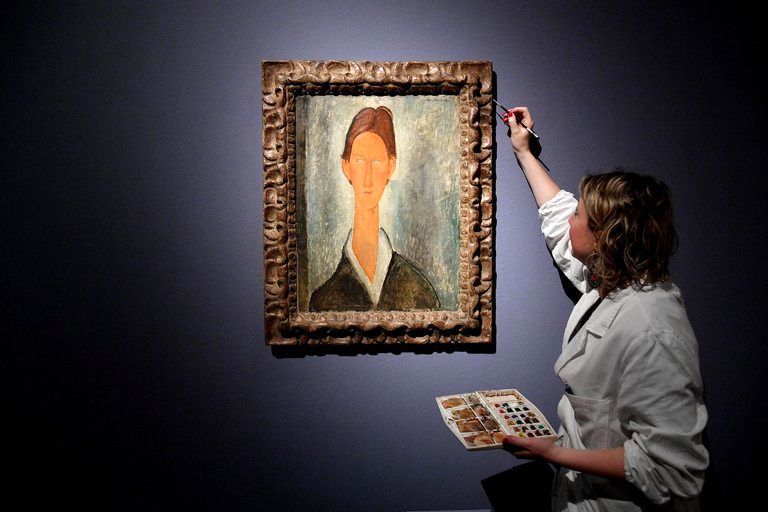The Authenticity of Modigliani Paintings Questioned Once Again

IranArt - The tormented artist Amedeo Modigliani is beloved both by art aficionados and forgers. Now, an art expert has written a report, leaked by the Italian news media, for state prosecutors that says a third of the works in a popular Modigliani exhibition last year in Genoa, Italy, are fakes.
Based on New York Times report, the expert, Isabella Quattrocchi, said that seven drawings and eight oil paintings by Modigliani, as well as six oil paintings attributed to his friend and sometime collaborator, Moise Kisling, were not authentic. The art works were lent by private collectors and museums in Italy, Switzerland, Israel, Argentina and the United States.
Ms. Quattrocchi said in the report that the works had been “crudely forged,” “both in terms of style and pigments,” according to the news agency ANSA. She also wrote that the frames came from Eastern Europe and the United States, and had little to do with Modigliani in terms of context and historical period, ANSA reported this week.
Ms. Quattrocchi, an independent art expert, wrote her report for prosecutors in Genoa. Three people are formally under investigation, including Rudy Chiappini, the curator of the Genoa show, which ran for four months last year at the Palazzo Ducale, a prestigious exhibition venue — but no one has been charged. The exhibition was shut down three days early, after art experts began questioning the works. Ms. Quattrocchi and the Genoa prosecutor’s office did not respond immediately to requests for an interview.
Mr. Chiappini has challenged the expert’s findings, pointing out that all the paintings in the exhibition had been included in catalogs of Modigliani’s works, and had been exhibited before.
“The exhibit did not have any new attributions, and none of the works in the show had been contested before; they were all known and accepted,” Mr. Chiappini said in a telephone interview from Switzerland. “So if someone claims they are false, it has to be verified.”
If the fakes are confirmed, he said, investigators “will have to get to the top of the pyramid to see who first certified them as being original.”
He added, “I am at the foot of this pyramid, not the top.”
The is not the first time that works by Modigliani have come under scrutiny, and authentication has always been tricky, in part because experts have not come to agreement on a complete and definitive catalogue raisonné of the artist’s work.
One of the paintings that Ms. Quattrocchi identified as false, a head of a woman, possibly Hanka Zborowska, the wife of Modigliani’s art dealer, has been in a private Milanese collection since 1998. Giuseppina Antognini, the owner of the painting, said she was “taken aback” to discover that the work might not be authentic.
“This painting has an important pedigree that dates back decades,” Ms. Antognini said in a telephone interview. It had been included in exhibitions in Italy and abroad, including at the Modern Art Gallery here, in 1959, she said. “For me it was authentic.”
And she added that in 1972, the state placed the work on a list of art that could only be sold under certain conditions because it was considered important to the country’s cultural heritage.
Ms. Antognini said that her foundation, the Fondazione Pasquinelli — which she founded in 2011 after the death of her husband, the collector Francesco Pasquinelli — would also hire an expert to examine the painting, which she intends to bequeath to an institution. “It’s not a question of its value, but I want to know whether it is authentic or false,” she said. “All I know that this painting has a strong pedigree,” she said.
If there is a formal criminal indictment, any defendant will also be able to ask the court for an independent appraisal of the suspect works of art.
Cesare Dal Maso, a lawyer who represents an “important Swiss family” that lent three paintings that have been confiscated, said he found it strange that prosecutors had not allowed his clients to appoint their own art appraisers yet.
“Whatever happens, these paintings have now been tainted” by the report, he said.
“My clients didn’t want to loan the works, and had to be persuaded,” Mr. Dal Maso continued. “I guess they were right.”
A lawyer for the foundation that runs the Palazzo Ducale said that the museum considered itself the injured party. The investigation is still ongoing and the expert’s report should not have been released, said Cesare Manzitti, the lawyer representing the foundation. “This is a phase where it should have been secret but became public,” he said. “After all, this is Italy.”

